The bell tower spire of Mont St. Michel seemed an apparition, soaring above the Normandy wheat fields. We had left our farmhouse B&B early in the misty morning to drive a short back road route to the famous abbey. Would our photos register this ethereal site? Walking the long tideland causeway toward the rock-perched abbey, the seeming mirage changed as we discerned turrets, walls, and windows. Fast-running currents of the receding tide rushed by us as we passed boats temporarily grounded at their anchorage. The ghosts of England and France’s past surrounded us as we excitedly skirted the bay waters and ducked through a tight, rock-wall portal to discover the abbey’s treasures.
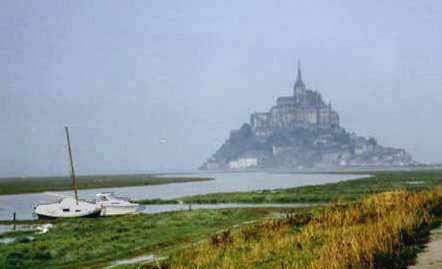 |
We were on a voyage of discovery along northern France’s Normandy coastline, and the highlights still sparkle in our memory -- the unparalleled physical beauty and visible history of Mont St. Michel; the emotion-rending D-Day beaches and monuments; the inviting port of Honfleur, which so well preserves Normandy’s unique architecture, culture, and cuisine.
| Mystical Mont St. Michel Although we arrived early, Mont St. Michel’s single street was already bustling with activity. Before climbing to the abbey, we stuck our head into La Mere Poulard, the world-famous omelette restaurant, for a sight of the costumed kitchen personnel in action, beating up their eggs. Then we followed the narrow street, shadowed by half-timbered hotels and buildings, as it climbed and circled the island to the abbey’s Grand Stairway. After reaching the fortified entrance, we continued our climb to the abbey’s top level. |
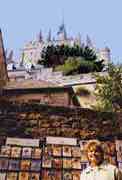 |
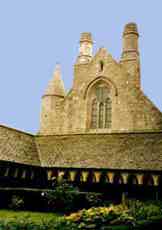 |
From the west terrace, the Normandy and Bretagne coast line spread in an unforgettable
panorama. Then gazing upward, we viewed the neo-Gothic spire and gold leaf statue of
Michael the Archangel, the island’s namesake. Entering the abbey church, we admired
the high arches and celestory, then followed multiple doorways and stairways through the
incredible abbey from the top floor to the bottom. With each level we stepped further back
in time, marveling at the varying medieval architecture. The impact of Mont St. Michel’s history seeped into our bones as we visited the monk’s cloister garden, the refectory, the Knights’ Hall, and the almshouse, where poor pilgrims were fed and lodged. We smiled as we saw the giant treadmill and imagined the monks, six at a time walking hamster-like, hauling up heavy loads of building supplies during the abbey construction. |
| The island’s history started in 708 when the bishop of Avranches, following a vision of Archangel Michael, declared it as a Christain pilgrimage site. The abbey was started in 1,000 AD by Benedictine monks who worked non-stop for six centuries. The foundations and first floor are Romanesque, and the higher structure is Gothic. The island’s thick fortress walls and strong surrounding tides enabled it to well withstand attacks throughout its history. During the French Revolution, the abbey functioned as a prison. In 1874 the French government converted it into a national monument and built the causeway. Today Mont St. Michel stands as a United Nations World Heritage site -- a status which we well appreciated as we descended to the causeway and the now advancing tide. | 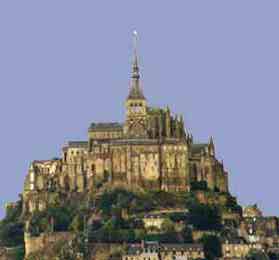 |
Desolate D-Day Beaches
The drive north inland from Mont St. Michel revealed a varying countryside of apple orchards, dairy farms, wheat fields and small villages along gently rolling terrain. The city of Bayeux was worth the stop for a lunch break and a visit to the famous Bayeux Tapestry. Embroidered in wool in the 11th century, it displays pictorially along its 230 feet length the saga of William the Conqueror and his victory over the English in 1066.
Leaving Bayeux, the air turned cool and salty as we neared the section of Normandy’s coastline where the Allies staged WWII’s D-Day invastion. Most recently portrayed in Spielberg’s Saving Private Ryan, this is where Britain, Canada, and the U.S. carried out the largest military operation in history, successfully breaking through the Nazi line and establishing a front for liberating Europe. In the early morning of June 6, 1944, Allied forces hit five landing beaches under heavy German fire. Casualties were highest at Omaha Beach, near the villages of St. Laurent and Coleville Sur Mer, now the site of the American cemetery.
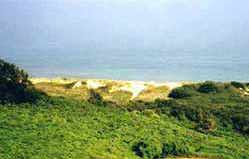 |
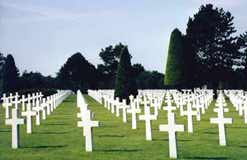 |
Here we walked quietly through row upon row of white marble crosses and Stars of David in a vast expanse of perfectly manicured lawn. Below the cemetery on its bluff, the battle beach and English Channel shimmered in the sunlight. The desolate, windswept bluff and beach belie the battle intensity of D-Day, but the cemetery and nearby monument well preserve the soldiers’ spirit. It was moving to see the expanse of 9,400 headstones, each marked with the name and home town of an American who died during the invasion. An equally moving experience was viewing the monument-inscribed list of over 1,500 Americans, missing in action durirng the operation.
The nearby Museum of Debarkation in the town of Arromanches sits above the site of the first-ever prefab harbor. We viewed in awe the model reconstruction of the harbor and an audio-visual presenation which recounts this stage of the invasion. The seven mile long harbor, conceived by Winston Churchill, was constructed from a score of old ships and over 100 huge cement blocks towed across the English Channel and sunk in the bay to create a safe landing harbor. Within a few days after D-Day, an additional 54,000 vehicles and 500,000 troops were debarked here to continue the Allied campaign against Germany.
| Honfleur Preserves its Normandy Port Heritage After a peaceful drive west through quaint coastal resort towns such as Deauville and Trouville, the little harbor town of Honfleur provided the perfect cap to our tour of the Normandy coastline. Parking nearby, we ventured into the maze of cobbled, pedestrian-only streets of the old town. Our search for a hotel was rewarded with a well-priced and comfortable, half-timbered old establishment near the harbor. Then with the setting sun as a perfect backdrop, we set out on our explorations of Honfleur. |
 |
The old harbor, or Vieux Bassin, bustled with the energy of the town’s residents, street musicians, and vacationers, all enjoying the perfect charm of Normandy’s yesterdays. The old dock shelters centuries-old Norman boats with uniquely shaped sails, while four and five-story traditional Norman homes and apartments tower, wall-to-wall, over the harbor. The large stone "Lieutenance," former dwelling of the King’s harbor governor in the 1600s, stands guard at the entrance to the old harbor.
As we ventured into meandering streets with names such as rue Brulee and rue de la Prison, we encountered more half-timbered homes and small plazas, or places. In one plaza we were fortunate to come upon a group of traditionally costumed dancers, who put on a great demonstration of Normandy’s cultural heritage.
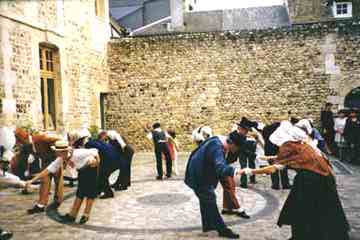 |
As we continued our exploration we came upon France’s only wooden church, Ste. Catherine. It was built in the 1400s and 1500s during and after France’s Hundred Years War with England. Since all of France’s stone masons were occupied in rebuilding other sections of the country, Honfleur utilized its shipwrights to construct Ste. Catherine, including its hull-shaped naves and the seperately standing bell tower, covered with chestnet-wood shingles.
With dusk settling in on the town, we walked back to the port to find a harborside, outdoor terrace for dinner. It was fit for a French king -- fresh prawns, market vegetables, cider, Normandy cheese plate, apple tart, and the traditional Calvados liquer -- a fitting end to our Normandy coast discoveries.
Click here for details to plan your own trip to Normandy.
Les Furnanz
Photos: Rita Furnanz